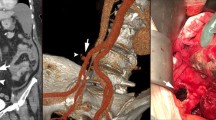Abstract
Corona mortis (CMOR) is an anastomotic branch between the external iliac or inferior epigastric vessels and the obturator artery or vein, or any vascular connection between the obturator and the external iliac systems in general with high anatomic variability. The aim of this study was to evaluate the type of anastomosis, if arterial, venous or both and the other subtypes of CMOR. Twenty-five laparoscopic procedures of bilateral pelvic lymphadenectomy for gynecological oncologic procedures (50 half pelvises) were performed. CMOR was located in 15 half pelvises on the right side (60 %), in 7 half pelvises on the left side (28 %), in 3 patients it was evidenced bilaterally. CMOR was dissected in 26/50 (52 %) half pelvises. Venous anastomosis was more frequently (46 %) followed by both venous and arterial vessels; in only 8 % (2/26) an arterial communication was observed. 83 % of venous anastomosis were single communications. One isolated arterial anastomosis was evidenced in two patients. In the cases of both arterial and venous anastomosis, one venous and one arterial vessel in 5/6 (83 %) were detected, and one type of anastomosis with one arterial and two venous vessels. Our data suggest that venous CMOR is usually present in higher frequency than the arterial one, followed by the combined type with arterial and venous connections. The isolated venous anastomosis resulted the frequent subtype.

Similar content being viewed by others
Abbreviations
- CMOR:
-
Corona mortis
- EIA:
-
External iliac artery
- EIV:
-
External iliac vein
- OV:
-
Obturator vein
- OM:
-
Obturator muscle
- ON:
-
Obturator nerve
- IEA:
-
Inferior epigastric artery
- IEV:
-
Inferior epigastric vein
- PB:
-
Pubic branch
- BMI:
-
Body mass index
References
Berberoglu M, Uz A, Ozmen MM et al (2001) Corona mortis: an anatomic study in seven cadavers and an endoscopic study in 28 patients. Surg Endosc 15:72–75
Darmanis S, Lewis A, Mansoor A, Bircher M (2007) Corona mortis: an anatomical study with clinical implications in approaches to the pelvis and acetabulum. Clin Anat 20:433–439
Ebraheim NA, Liu J, Lee AH et al (2008) Obturator artery disruption associated with acetabular fracture: a case study and anatomy review. Inj Extra 39:44–46
Hong HX, Pan ZJ, Chen X, Huang ZJ (2004) An anatomical study of corona mortis and its clinical significance. Chin J Traumatol 7:165–169
Andrada Hamer M, Larsson PG, Teleman P et al (2013) One-year results of a prospective randomized, evaluator-blinded, multicenter study comparing TVT and TVT Secur. Int Urogynecol J 24(2):223–229
Larsson PG, Teleman P, Persson J (2010) A serious bleeding complication with injury of the corona mortis with the TVT-Secur procedure. Int Urogynecol J 21(9):1175–1177
Gobrecht U, Kuhn A, Fellman B (2011) Injury of the corona mortis during vaginal tape insertion (TVT-Secur™ using the U-Approach). Int Urogynecol J 22(4):443–445
Hubka P, Svabik K, Martan A, Masata J (2010) A serious bleeding complication with injury of the corona mortis with the TVT-Secur procedure: two cases of contact of TVT-S with the corona mortis during cadaver study. Int Urogynecol J 21(9):1179–1180
Hong HX, Pan ZJ, Chen X, Huang ZJ (2004) An anatomical study of corona mortis and its clinical significance. Chin J Traumatol 7(3):165–169
Pungpapong SU, Thum-umnauysuk S (2005) Incidence of corona mortis; preperitoneal anatomy for laparoscopic hernia repair. J Med Assoc Thai 88(Suppl 4):S51–S53
Kumar D, Rath G (2007) Anomalous origin of obturator artery from the internal iliac artery. Int J Morphol 25:639–641
Rusu MC, Cergan R, Motoc AG, Folescu R, Pop E (2010) Anatomical considerations on the corona mortis. Surg Radiol Anat 32:17–24
Sañudo JR, Roig M, Rodriguez A et al (1993) Rare origin of the obturator, inferior epigastric and medial circumflex femoral arteries from a common trunk. J Anat 183:161–163
Conflict of interest
None.
Author information
Authors and Affiliations
Corresponding author
Additional information
All authors contributed substantially to this article and are in agreement with its content. The authors have no commercial, proprietary, or financial interest in the products or companies described in this article.
Rights and permissions
About this article
Cite this article
Pellegrino, A., Damiani, G.R., Marco, S. et al. Corona mortis exposition during laparoscopic procedure for gynecological malignancies. Updates Surg 66, 65–68 (2014). https://doi.org/10.1007/s13304-013-0245-9
Received:
Accepted:
Published:
Issue Date:
DOI: https://doi.org/10.1007/s13304-013-0245-9




